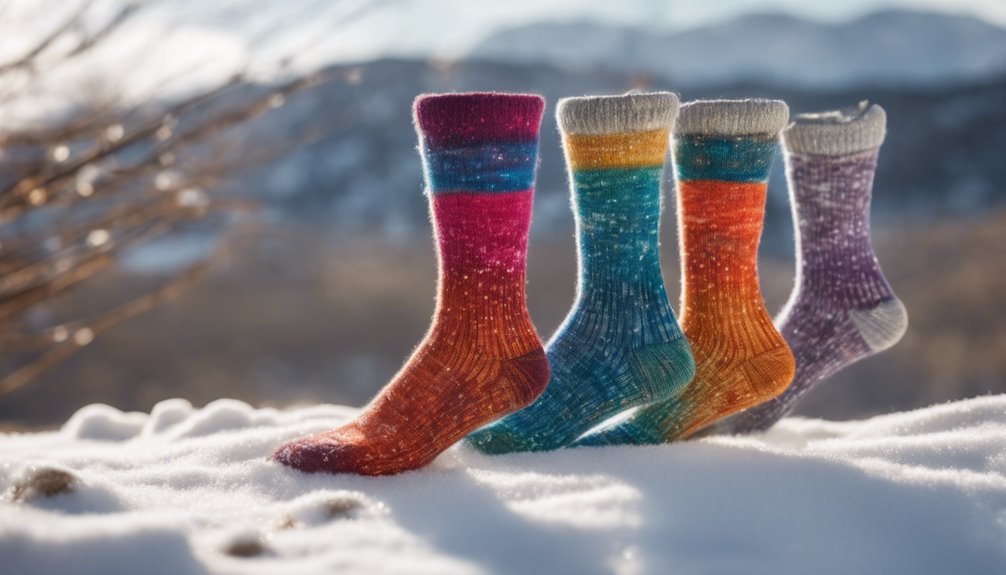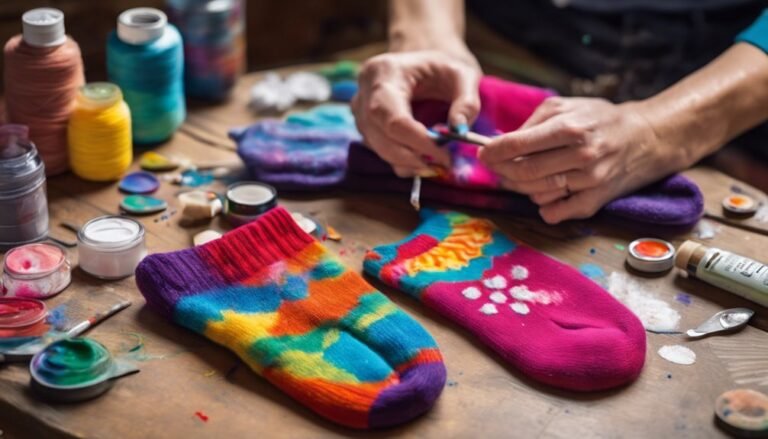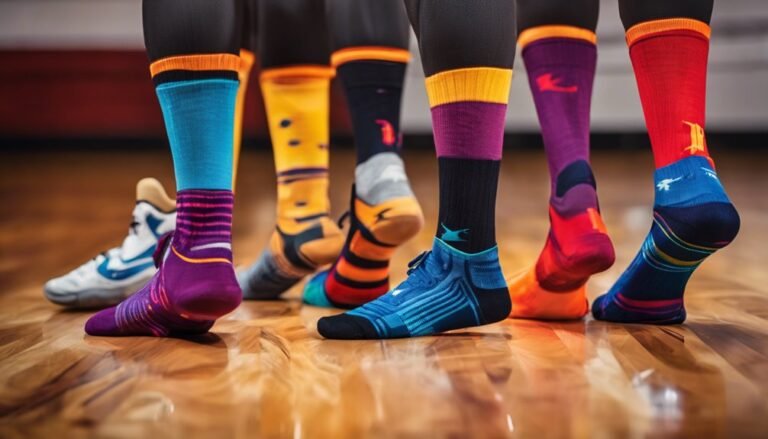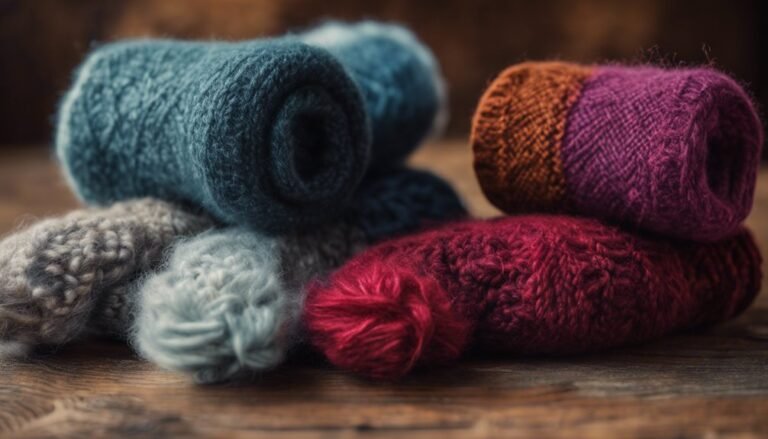How to Choose Socks for Extreme Cold Conditions
Choosing socks for extreme cold conditions involves focusing on materials and features. Opt for moisture-wicking merino wool or synthetic blends that provide insulation and dry quickly. Look for snug fits that prevent bunching and blisters, while thickness can enhance warmth without sacrificing circulation. Layering is also effective—use a moisture-wicking base layer with an insulating outer layer. Don't forget to check for reinforced areas for durability and proper care to extend their lifespan. Explore which specific features can enhance your cold-weather experience.
Understanding the Importance of Sock Materials

When you're braving extreme cold, the materials of your socks can make all the difference in your comfort and warmth. Choosing the right fabric guarantees peak sock breathability, allowing moisture to escape while keeping your feet dry. This is vital, as dampness can lead to chilling and discomfort. Additionally, look for materials that provide effective thermal regulation, trapping heat without overheating. Natural fibers like merino wool excel in this area, but some synthetic blends can also perform well. Prioritizing these qualities in your sock selection lets you maintain freedom of movement and enjoy your outdoor adventures without the nagging cold. So remember, the right sock material isn't just a luxury; it's indispensable for your comfort in extreme conditions.
Wool vs. Synthetic: Which Is Best for Cold Weather?
When it comes to choosing socks for extreme cold, understanding the insulation properties of wool versus synthetic materials is essential. Wool naturally retains warmth even when wet, while synthetic options excel in moisture management and drying speed. Knowing these differences can help you make the best choice for your cold-weather adventures.
Insulation Properties Comparison
Choosing the right insulation for your socks can make a significant difference in extreme cold conditions. When comparing wool and synthetic materials, consider their thermal efficiency and insulation ratings. Wool, known for its natural insulating properties, retains warmth even when wet, making it a reliable choice for freezing temperatures. Its insulation rating is generally higher than that of many synthetics, providing excellent heat retention.
On the other hand, synthetic materials often offer lightweight options with quick-drying capabilities, which can be advantageous for active individuals. However, they might not match wool's overall thermal efficiency. Ultimately, your choice should reflect your specific needs: comfort, warmth, and activity level. Prioritize insulation that will keep you warm while allowing freedom of movement in extreme conditions.
Moisture Management Differences
Insulation isn't the only factor to contemplate for sock performance in extreme cold; moisture management plays a significant role too. Choosing between wool and synthetic materials hinges on their moisture absorption rates and techniques. Here's a quick comparison:
- Wool: Naturally wicks moisture, keeping your feet dry and warm, even when wet.
- Synthetic: Often dries faster but can retain moisture against your skin, leading to chill.
- Hybrid Options: Combine the benefits of both, offering warmth and quicker drying times.
Understanding these moisture management techniques can keep your feet comfortable during outdoor adventures. Ultimately, your choice should reflect your activity level and personal preference for the best cold-weather performance.
The Role of Thickness in Insulation
While the thickness of your socks might seem like a minor detail, it plays an essential role in your overall warmth during extreme cold conditions. Thicker socks provide significant sock thickness benefits, as they create an insulating layer that traps heat close to your feet. This insulation helps maintain your body's core temperature, showing the thermal regulation importance in cold environments. However, keep in mind that excessively thick socks can lead to discomfort or restricted circulation. Ideally, you want a balance that allows for both warmth and freedom of movement. By choosing the right thickness, you enhance your outdoor experience, ensuring your feet stay warm and dry, making those winter adventures more enjoyable.
Fit and Comfort: Finding the Right Size
When it comes to extreme cold conditions, the fit of your socks is just as essential as their thickness. A snug fit guarantees warmth and prevents blisters, which can be critical when you're out in the elements. To find the perfect size, refer to sizing charts for the brand you're considering. Here are three key points to remember:
- Measure your foot: Accurate measurements help you choose the right size.
- Consider sock thickness: Thicker socks may require a larger shoe size for comfort.
- Test comfort levels: Try them on with your winter boots to ascertain they don't pinch or bunch.
Moisture-Wicking Properties for Dry Feet

Choosing the right socks for extreme cold conditions means prioritizing moisture-wicking properties to keep your feet dry and comfortable. When you're out in frigid temperatures, moisture retention can lead to cold and damp feet, which can be dangerous. Look for socks made from materials like merino wool or synthetic fibers that actively pull sweat away from your skin. This not only helps in temperature regulation but also minimizes the risk of blisters and discomfort. A good moisture-wicking sock will maintain a microclimate around your foot, ensuring you stay warm while avoiding that clammy feeling. Remember, keeping your feet dry is essential for overall warmth, so invest in quality socks that focus on moisture management for your adventures.
Layering Techniques: When to Use Multiple Pairs
Layering socks can drastically improve warmth and comfort in extreme cold conditions. By selecting the right materials and combining different pairs effectively, you can enhance insulation while managing moisture. Understanding the benefits and ideal combinations will help you stay warm and dry in frigid environments.
Benefits of Layering Socks
While many outdoor enthusiasts underestimate the importance of sock selection, layering can considerably enhance your comfort and warmth in extreme cold conditions. Sock layering not only aids in temperature regulation but also provides several advantages:
- Moisture Management: The inner layer wicks sweat away, keeping your feet dry.
- Insulation: The outer layer traps heat, providing an additional barrier against the cold.
- Custom Fit: You can adjust the tightness and thickness by choosing different sock combinations, ensuring a snug fit without restricting circulation.
Choosing Sock Materials
When it comes to extreme cold conditions, selecting the right sock materials can make a significant difference in your comfort and warmth. Look for socks made from high-quality merino wool or synthetic blends, as they offer excellent temperature regulation and moisture-wicking properties. Merino wool retains heat even when wet, providing unmatched insulation. Consider sock durability; a robust sock can withstand the wear and tear of rigorous activities while keeping your feet cozy. Avoid cotton, as it traps moisture and can lead to cold feet. If you're layering, opt for a thin moisture-wicking base layer underneath a thicker insulating sock. This combination enhances warmth without sacrificing freedom of movement, ensuring you stay comfortable during your outdoor adventures.
Optimal Pair Combinations
Choosing the right sock materials sets the foundation for warmth, but knowing how to layer them effectively can enhance your protection against extreme cold. Here's how to achieve ideal pair combinations:
- Base Layer: Start with a moisture-wicking thin pair for sweat management.
- Insulating Layer: Add a thicker wool pair for warmth; choose ideal color combinations that suit your outerwear.
- Outer Layer: Consider the sock length; over-the-calf styles can keep snow and cold air from entering.
Special Features to Look For in Cold Weather Socks
To guarantee your feet stay warm and dry in extreme cold, it's essential to look for specific features in cold weather socks. First, opt for socks with thermal cushioning; this extra padding not only provides comfort but also enhances insulation, keeping your feet toasty. Next, make sure they offer good arch support, as this will help prevent fatigue during long periods of activity. Look for moisture-wicking materials that draw sweat away from your feet, reducing the risk of cold and blisters. Additionally, consider socks with a snug fit to prevent bunching, which can lead to discomfort. Finally, don't underestimate the value of reinforced toes and heels for durability. With these features, you'll be well-equipped to embrace the cold with confidence.
Care and Maintenance for Longevity of Your Socks

Although it might seem simple, proper care and maintenance can greatly extend the life of your cold weather socks. To keep them in top shape, follow these essential tips:
- Sock Washing: Always wash your socks in cold water using a gentle cycle. Avoid fabric softeners as they can break down fibers.
- Drying Techniques: Air dry your socks whenever possible. If you must use a dryer, opt for a low heat setting to prevent damage.
- Storage: Store your socks in a cool, dry place, avoiding direct sunlight to prevent fading and deterioration.
Frequently Asked Questions
Can I Wear Cotton Socks in Extreme Cold Conditions?
You shouldn't wear cotton socks in extreme cold. Cotton sock disadvantages include poor thermal insulation properties, leading to cold feet. Opt for materials like wool or synthetic blends that provide better warmth and moisture management.
How Often Should I Replace My Cold Weather Socks?
If you think your socks can last forever, think again! For ideal sock lifespan, replace them every six months, especially after heavy use. Regular maintenance guarantees warmth and comfort, giving you the freedom to explore outdoors!
Are There Any Specific Brands Known for Extreme Cold Socks?
When searching for extreme cold socks, consider brand recommendations like Smartwool and Icebreaker. They use high-quality wool and synthetic blends, ensuring warmth and moisture-wicking properties. Prioritize materials that keep your feet comfortable and dry in harsh conditions.
What Is the Best Way to Dry Wet Socks Quickly?
To dry wet socks quickly, use sock drying techniques like wringing them out, then placing them near a heat source. Effective moisture management prevents dampness, keeping your feet warm and comfortable during your adventures.
Can I Use Compression Socks in Cold Weather?
Yes, you can use compression socks in cold weather. They provide compression benefits that enhance circulation improvement, keeping your feet warm and comfortable while allowing you the freedom to enjoy outdoor activities without worrying about cold extremities.







